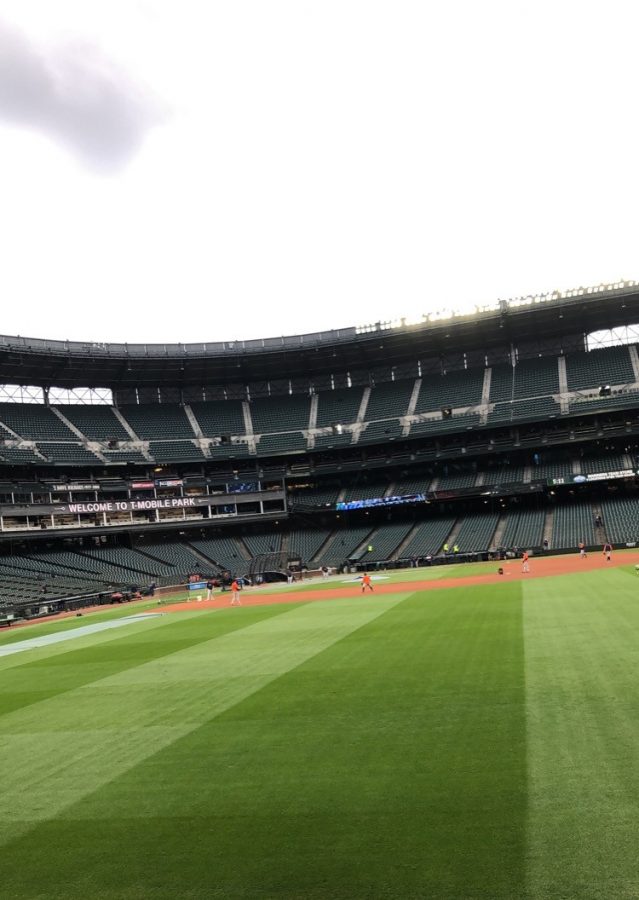The MLB Lockout Has Begun
The Houston Astros on field before a matchup with the Seattle Mariners on August 30, 2021
December 15, 2021
For the first time since 1994, there is a lockout in the MLB. The MLBPA (Major League Baseball Players Association) and the owners couldn’t reach a deal on the Collective Bargaining Agreement, meaning that all baseball activities are paused until a deal is reached. The CBA is described as “the negotiated accord that governs almost every aspect of the working relationship between Major League Baseball players and team owners” (CBS Sports)
The owners and the MLBPA had been meeting over various issues such as player salaries, service time manipulation, and tanking. Service time manipulation is the action of holding prospects below the major league level for a season to keep them off the service time clock, giving their club control before they enter free agency. Tanking is a “strategy” among struggling teams that likely have little to no shot at competing for a championship. They will intentionally struggle to worsen their record, thus giving them a higher pick and likely a future star player.
In 1994, the season was halted on August 12 after talks of the previous CBA that expired on December 31, 1993 officially broke down. MLB owners had a worsening financial situation and proposed a salary cap be added to the MLB, limiting teams on money to spend. The lockout ended up causing major waves throughout the league, as the season was never resumed and the postseason canceled, the first time this had even happened.
It is also thought that the ‘94 lockout led to the downfall and subsequent relocation and rebrand of the Montreal Expos. The Expos were having an underdog season in 1994, sitting pretty with the best record in baseball at the time. Some think Montreal could have been headed to a championship, with Sports Illustrated writing a piece on the Expos for their “What If” Series (https://www.si.com/specials/greatest-sports-what-ifs/mlb/2017/montreal-expos-1994-world-series-mlb-strike-what-if) Unfortunately, it wasn’t to be, as the Expos moved to Washington DC in 2005 and became the Nationals.
But here in 2021, the age of social media has given players a voice to speak out. One of the lockout’s major stipulations is that MLB can’t use player likenesses, meaning there are no photos of current players on the MLB website or any team website. Every player image on the rosters has been replaced with a blank image of a silhouetted baseball player. (https://www.mlb.com/mariners/roster) In response to this, various MLB players like Mitch Haniger and J.P Crawford have made their profile pictures on Twitter those same blank faces.
People are split on their support for the lockout. Many people are in support of the Players Association, as the owners seem to want more money. MLB commissioner Rob Manfred seems to be in support of the owners, much to the anger of baseball fans. “Manfred sucks, get him out,” Sophomore and GP baseball player Karsten Sweum says. Manfred has been at the center of controversy for years. Fans thought he didn’t do enough to punish the Houston Astros after they were caught cheating in 2017, going so far as to say the championship shouldn’t be revoked solely because the trophy was just a “piece of metal.”
Sophomore Angus Van Valey believes that both sides can take some fault. “Basically, both sides are greedy for wanting more money, and big market teams especially. The big market teams want a luxury tax threshold increase which screws over small market teams and mid-tier free agents.”
The luxury tax, also known as the Competitive Balance Tax, is the cap on spending for MLB teams. Unlike other major sports, the MLB has no salary cap, instead they have a luxury tax. If a team goes over the luxury tax threshold, there are penalties. “A club exceeding the Competitive Balance Tax threshold for the first time must pay a 20 percent tax on all overages. A club exceeding the threshold for a second consecutive season will see that figure rise to 30 percent, and three or more straight seasons of exceeding the threshold comes with a 50 percent luxury tax. If a club dips below the luxury tax threshold for a season, the penalty level is reset. So, a club that exceeds the threshold for two straight seasons but then drops below that level would be back at 20 percent the next time it exceeds the threshold,” is how the MLB describes the punishment. An increased luxury tax threshold would mean teams with more money could spend more money on big free agents without having to pay a fee, thus hurting the smaller teams with less to spend.
(You can read the full explanation here: https://franchisesports.co.uk/mlb-luxury-tax-explained/
Junior Logan Hall gets right to the point with his thoughts, saying “owners are greedy.”
Sophomore Evan Marquardt likes the lockout, saying he agrees with it. “I think it does good. [The players] get paid too much to go on strike anyways, they shouldn’t be in the first place,” Marquardt said.
Nearly a week has gone by since the lockout has begun and no progress has been made, at least publicly. Speculation has begun to arise that the lockout could cut into spring training, meaning a possible 3rd consecutive year with an abbreviated spring training.
Manfred released a letter at the beginning of the lockout that was penned to the fans. The Players Association then did the same thing. Fans were unhappy with Manfred’s letter, thinking he was using them as a pawn to get what he wanted. You can read Manfred’s letter here:
https://www.mlb.com/news/featured/a-letter-to-baseball-fans


